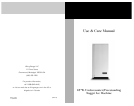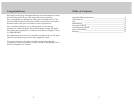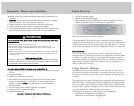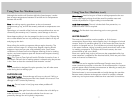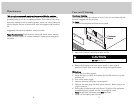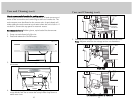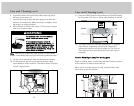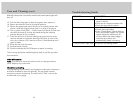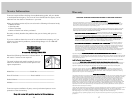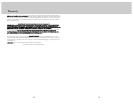
Although the machine will function within the listed ranges, it works
best at water temperatures between 50 and 60 and air temperatures
between 60 and 80.
Note: Ice making capacity goes down as the environmental
temperatures go up, and will be severely reduced at temperatures over
90
o
F.
Operating a unit outside of the limits can cause problems that are not
covered by the warranty and, if extreme, cause damage to the unit.
Never keep anything in the ice storage bin that is not ice. Objects like
wine or beer bottles are not only unsanitary, but the labels can slip off
and plug up the drain.
Never allow the machine to operate without regular cleaning. The
machine will last longer if it is kept clean. Regular cleaning should
happen at least once per year, and preferably twice. Some water
conditions will dictate even more frequent cleaning of the ice making
section, and some carpets or pets will dictate more frequent cleaning
of the condenser.
Note: The Time to Clean light will switch ON after 6 months of use. It
will remain ON until the ice making system is cleaned using the process
in the “How to clean the condenser and winterize” section.
Noise
The ice machine is designed for quiet operation, but will make some
noise during the ice making cycle.
OUTDOOR USE
Keep from freezing. Severe damage will occur to the unit if left in or
operated in temperatures beyond the limits listed in this manual. That
damage is NOT covered by warranty.
Keep dry. Do not locate in low lying areas where puddles will
accumulate.
Provide Shade: Heat gain from the sun will reduce the unit’s ability to
make and store ice, and ultraviolet radiation from the sun can
potentially damage the unit’s plastic components.
Water Supply: Avoid a long run of hose or tubing exposed to the sun.
Plastic water supply tubing should be rated for potable water and
include UV protection. Copper tubing is recommended.
Back Flow Prevention: The unit includes back flow prevention, no
additional check valve is required.
Drainage: Do Not drain into swimming pool or onto grounds.
WATER QUALITY
The water to the machine must be potable, or fit for human
consumption. Beyond that, water supplies vary in the degree of mineral
content. As this ice machine makes ice, all the water that flows into the
machine is changed into ice. That includes any minerals that might be
in the water. However, during ice making some minerals will stick to the
ice making components. The higher the mineral content, the more
mineral build up will occur. Water
filters are a partial help, as they will remove the suspended solids, but
water treatment is needed for the dissolved solids, which are part of the
water and cannot be filtered out.
RO Water
This machine can be supplied with Reverse Osmosis water, but the
water conductivity must be no less than 10 microSiemens/cm. A reverse
osmosis system should include post treatment or blending to satisfy the
R.O. water’s potential aggressiveness.
Deionized water is not recommended and could damage the machine.
Because water softeners exchange one mineral for another, softened
water may not improve water conditions when used with ice machines
6 7
Using Your Ice Machine (con’t)
Using Your Ice Machine (con’t)



